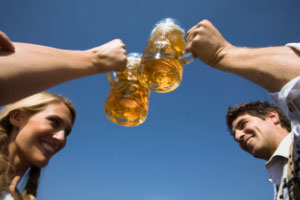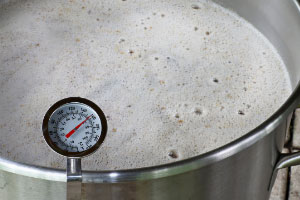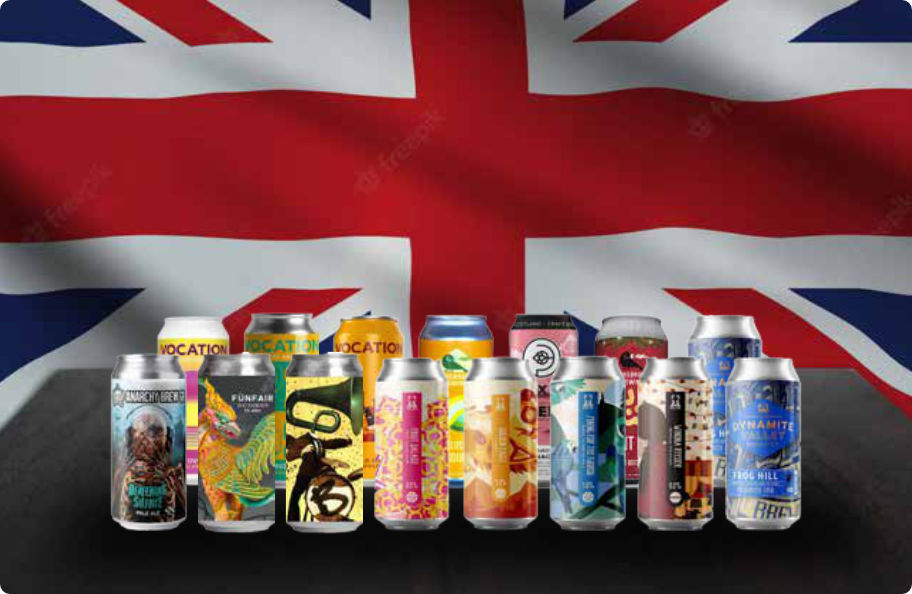Guides and Facts
What Is Beer?
What exactly is beer? Everything you need to know about the nation’s favourite drink
Most of us have sipped on a cool refreshing pint on a summer’s day or had a bottle or two of lager with an evening meal. But we rarely stop to wonder what lies inside that tasty amber nectar and how it came to occupy such a central role in our social lives. So what exactly is beer, where does it come from, and how did this magical brew first come into existence? Read on to find out all you need to know about this very unique drink…
The definition of beer: what exactly is it?

Beer is one of the oldest and most popular drinks in the world; in fact, it’s thought to be the third most popular drink after water and tea. Put simply, beer is an alcoholic beverage that’s made by fermenting cereal grains. These can include barley, wheat, maize and even rice. The finished product is usually a combination of water, malt, hops and yeast – which, as we’ll explain later on, is much more delicious than it sounds! Today, beer is consumed in bars, restaurants, cafes and homes around the world. It’s a drink that brings people together – lighter than wine, more refreshing than a spirit, it occupies a special place in our hearts – and our bellies.
The meaning of the word beer
Why is beer called beer, and what’s the meaning of the word itself? It’s a great question, and one that has two possible answers. The first is that beer is thought to have come from the Latin word “bibere” meaning “to drink”. But there’s another theory that the word beer comes from an old Germanic word “beuwoz” which means barley. Whichever theory is true, it’s hard to imagine beer being called anything else these days. And here’s something to remember for your next holiday: the word beer is used by languages all over the world – from the French word “bière” to the Italian word “birra” and the Turkish, “birra”. It’s a word that’s certainly here to stay.
The origin of beer: where did it come from?
You might think beer is a very modern phenomenon, but this is a drink that has been around for millennia. We know that cereal first began to be farmed around 10,000BC, so it’s quite possible that beer could have been produced around that time. In fact, the earliest known evidence that beer existed dates from 13,000 years ago in the Carmel Mountains of Israel. But perhaps one of the most fascinating facts we know about the history of beer is that workers who were building the Great Pyramids of Giza in Egypt were given a daily ration of four to five litres of beer for “refreshment and nutrition”. Now there’s something to tell your boss the next time he stops you having lunch time beers on a Friday!
How beer reached Europe
It’s quite possible that several cultures discovered beer independently, after discovering that almost any substance containing sugar could be fermented to produce alcohol. Bread and beer, both being the product of grain, were two of the biggest bringers of prosperity to early cultures, and historians have speculated that these humble products were actually huge factors in the building of civilizations.
Beer is thought to have been introduced throughout Europe by travelling Germanic and Celtic tribes as far back as 3000BC, when it was mostly brewed in homes rather than for commercial purposes. Fun fact: early European beers were a lot different to the beers we’re used to today – they may have included all sorts of weird and wonderful extra ingredients like fruits, honey, plants, spices, and even narcotic herbs. It makes you wonder how today’s craft breweries would measure up!
What are the ingredients in beer? A quick guide to beer’s contents
Usually, beer is only defined as beer if it contains these four central ingredients:
Water – this can account for up to 93% of the finished product’s content or weight. The water that goes into your beer has to be completely purified and free from all the additional chemicals that are in our normal tap water. Beer contains less alcohol per volume and more water than the majority of other alcoholic drinks, and that’s essentially why it is so good at quenching your thirst on a summer’s day. Interestingly, many beers are actually isotonic (meaning they have the same osmotic pressure as body fluids) and this means they have no harmful impact on the body’s water balance.
Barley – this is the traditional and most suitable grain of choice for making beer with, though there are alternatives. It’s as crucial to the beer making process as grapes are to producing wine. The barley itself is malted, which is where moisture is used to stimulate the germination of the grain. Once malted, the barley gives the beer its beautiful golden colour, as well as its malty flavour, protein for the formation of the foamy head at the top of your glass of beer, and most importantly, the natural sugars that are needed for the fermentation process. If brewers want to enhance or change the flavour of beer they can add different grains into the mix besides barley, for example wheat, oats and rye.
Hops – this is the ingredient that makes your beer taste bitter, and also give beers floral, fruity or citrus flavours. Hops come from the flower of the hop plant and contain a special oil that adds this flavour. To produce different levels of bitterness, you can use different types of hops or else add the hops in at different stages of the brewing process. Extra hop can be added during fermentation and this is called dry hopping. Fun fact; the hop plant and the cannabis plant have a similar taste and smell properties, which is why some experts think they could be related. Hops are also used in herbal medicine as remedies for anxiety and insomnia.
Yeast – Once the ingredients are brewed, a sweet liquid is left behind called wort. Yeast is added to the wort to begin the fermentation process, essentially turning all this sugar into alcohol. When reproducing, the yeast cells take in simple sugars like glucose and maltose and they give out waste products in the form of carbon dioxide and alcohol. Yeast cells produce other substances like ketones and fatty acids, which all combine to form different “notes” or flavours in your beer, from fruity to spicy or even hints of butterscotch.
How is beer made?

As anyone who has ever visited a brewery will tell you, making beer is a process that requires a lot of time, energy and skill. Today’s breweries use extremely precise temperatures and measurements, and cutting edge technology, to get the finished beer product just right. Here is a quick breakdown of what the beer making process usually involves:
1. Malting
The process begins with the grain, usually barley but as we’ve mentioned this might be a combination of different grain types. The grains themselves are harvested and then they go through a special process whereby they’re heated to bring about germination (when a seed begins to sprout). Then they’re dried out again. This produces specific enzymes that are essential to the brewing process.
2. Mashing
The grains are then steeped in hot water for about an hour, which has an important purpose: it activates the enzymes in the grains that cause them to break down and release that all-important sugar. Once finished, you’re left with a substance called wort, which is basically all the sugar and water that has been left over from the mashing. You could see this as the raw unmade beer, so to speak – almost like dough is before it’s turned into bread.
3. Boiling
The wort is then boiled for around an hour and during that time, hops and other flavouring ingredients are added at specific times. The hops themselves balance out the sweetness of the sugar with their bitterness.
4. Fermentation
The wort is cooled, strained and filtered. Now comes the crucial part: it goes into a fermenting vessel and yeast is added to it. The beer is then stored for a specific time period, usually a couple of weeks at room temperature for ales and many more weeks at cold temperatures for lagers. All the while, the beer itself is fermenting; behind the scenes the yeast is busy consuming all of the sugar in the wort and producing CO2 and alcohol as it goes.
5. Bottling and aging
By this stage, you’re left with a basic alcoholic beer, but it’s flat, as it still hasn’t had its fizz added to it. At the bottling stage the beer is either carbonated like with normal fizzy drinks, or it’s allowed to naturally carbonate using the CO2 the yeast has produced. The beer can be left to age for any period of time, after which it’s time for the fun part: enjoying the work of art that comes from this brewing process. Bottoms up! And while you’re picturing that delicious beer, we’ll answer a couple of lingering questions you might have…
What’s the difference between beer and lager?
This is a question that’s asked a lot by those who are new to beer. The answer is fairly straightforward: lager is in fact a type of beer, and it’s left to ferment in cooler temperatures and for longer periods than other types of beer, for example ale. The cooler temperatures allow for chemical reactions to happen more slowly, and this in turn affects characteristics like flavour and alcohol content. The resulting lager is smoother, lighter, and easier to drink than other beers, hence its popularity. By contrast, ales are fruitier, more full-bodied and more complex.
What is draught beer and how is it different to bottled beer?
While some beers are bottled, others are stored in kegs and served from there into glasses at pubs and bars around the world. This is called draught beer. The beer in this case is stored in a pressurized keg or cask that uses CO2 gas to propel the beer through the pipes to the tap, where it’s dispensed by your friendly bartender into that elegantly shaped pint glass. With this method there’s less exposure to light and oxygen and this prolongs the beer’s so-called shelf life. Some beers are pressurized with a nitrogen and CO2 mixture – the addition of nitrogen produces a head with fine bubbles and a creamy effect.
So, what is beer really? If you’re still not sure, here’s a bite-sized definition: it’s a delicious drink with a long history and a major global significance, from helping to build ancient Egyptian civilizations to creating the fantastic British pub culture that we enjoy today. Cheers to that!
If you’re thirsty after reading all this, we don’t blame you. Head over to the best beer selection you’ll find this side of the channel tunnel and pick out the perfect brew!
https://www.beersofeurope.co.uk/beer




